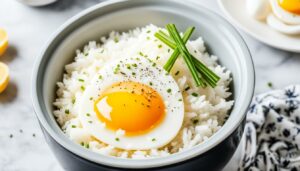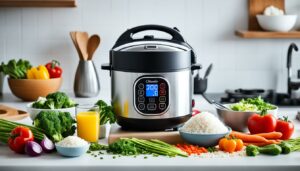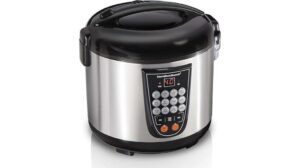Are you a rice lover looking for the perfect way to make delicious dal every time?
If so, then you’re in luck because, as I will demonstrate, with a simple rice cooker, you can whip up tasty recipes that are sure to satisfy even the most discerning palate.
In this post, I’ll provide step-by-step instructions on how to make perfect dal using your everyday appliance.
So, whether it’s green mung beans or red lentils that tickle your fancy, learn all my top tips and tricks so you can craft delectable meals with ease.
Table of Contents
What is Dal and Why Use a Rice Cooker?
Dal is an essential part of South Asian cuisine and is a dish made from split lentils, often served with rice. To cook dal properly, it requires very precise timing and temperature control.
This can often be difficult to achieve when using traditional cooking methods like boiling or frying and so, the use of a rice cooker has become increasingly popular for preparing dal due to its ease of use and consistent results.
When used for Dal, many people find that they get better results with a rice cooker than they do with traditional methods due to its precise control over time and temperature, as well as its ability to trap in the steam needed for proper cooking.
By trapping in steam during cooking, you can avoid burning or drying out your dal while ensuring even cooking throughout all of the lentils. Also, many modern rice cookers are equipped with multiple settings and programs specifically designed for different types of foods including dal. This allows you to easily customize your recipe according to your preferences without having to worry about any guesswork or manual adjustment during cooking.
Overall, using a rice cooker for making dal can be an extremely convenient way to create delicious dishes without having to put too much time or effort into it. With precise temperature control and easy-to-use programs designed specifically for this type of dish, you can make sure each batch turns out perfectly cooked every single time!
Different Types of Dal
Dal, also known as dhal, daal or dahil, is an Indian dish made from lentils, peas, or any type of pulse.
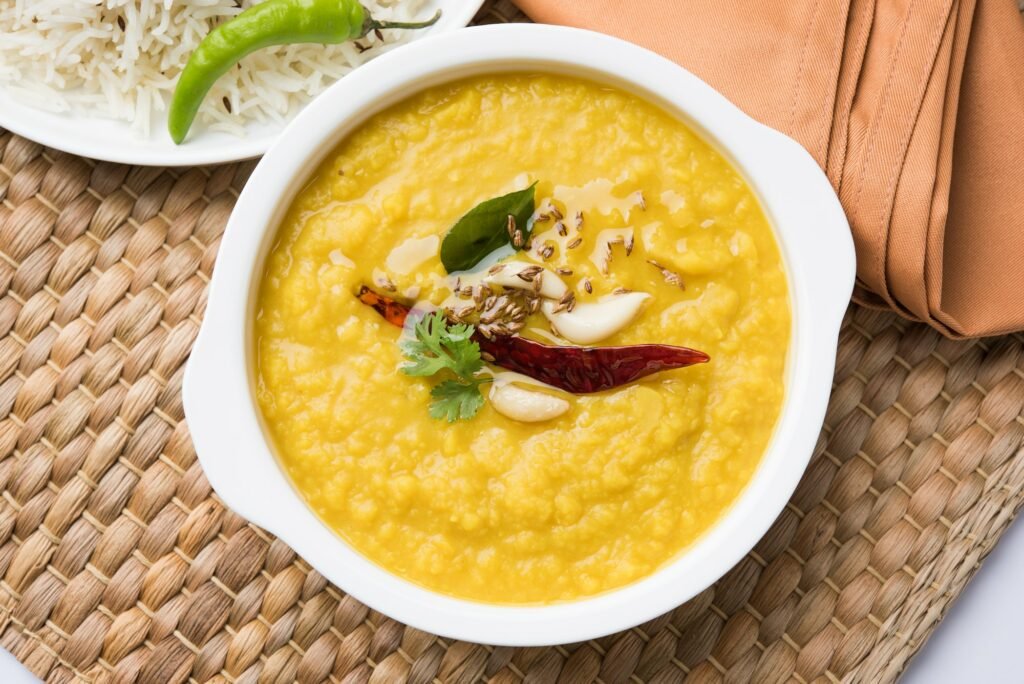
It is a popular dish in many parts of South and Southeast Asia and is one of the most common staple foods found throughout the region. Dal recipes vary from family to family, but typically involve boiling the pulses until they become soft and then either blending them with spices or seasoning them directly. The result is a thick soup-like consistency that can be enjoyed as a main course or side dish.
There are several different types of dal available depending on which pulses are used. The most common type is toor dal (also known as arhar dal), which is made from yellow lentils and has a nutty flavor when cooked. Other varieties include masoor dal (made from red lentils) moong dal (made from green lentils) and chana dal (made from split chickpeas).
Each variety offers its own unique flavors and textures, allowing you to create a wide range of delicious dishes.
The preparation of each type of dal also varies depending on the recipe being followed; some recipes call for frying the pulses before boiling while others opt for soaking them in water overnight before cooking.
Regardless of how it’s prepared, the end result will always be a delicious and nutritious meal that can be served with rice or naan bread for added texture and flavor.
Dal is often spiced with cumin seeds, curry leaves, ginger, garlic, turmeric powder and other herbs for extra flavor — making it an incredibly versatile dish that can be adapted to suit any palate.
Preparing and Cooking Dal to Perfection with a Rice Cooker
The most common type of dal is Chana Dal, which is made from dried split chickpeas. It’s an excellent source of protein, carbohydrates, and essential minerals and vitamins that make it a healthy and tasty meal.
As I’ve already said, one of the quickest and easiest ways to prepare dal is by using a rice cooker simply because they are designed to cook both rice and other grains such as dal perfectly every time, without requiring you to monitor the cooking process.
When cooking dal in a rice cooker, add 1 cup of dry dal to 2 cups of cold water or stock (vegetable stock works well). The ratio of liquid to grain should always be 2:1 for optimum cooking results. Add spices or herbs that you prefer for flavor if desired (cumin and turmeric are two classics).
Once all ingredients have been added to the cooker, close the lid and turn the heat setting onto high.
After about 10 minutes the machine will switch over to low heat automatically when it senses that all the liquid has been absorbed.
Allow it to continue cooking on low heat for another 30-40 minutes until all grains have softened completely.
Make sure to check on it frequently so that your dal does not get overcooked or too dry – adding a bit more liquid may help if this happens.
Once done cooking, let stand for about 10 minutes before serving.
Tips for Flavoring and Spicing Up Dal Recipes
While dal can be cooked in a variety of ways, the most common way to give it flavor is to add spices.
Spices are an important part of Indian cooking and are used to not only add flavor to food but also provide numerous health benefits. Adding spices to dal dishes can help bring out the unique flavor of each ingredient and create a balanced and flavorful dish that everyone can enjoy.
When adding spices to dal recipes, it’s important to choose the right combination that will enhance its flavors without overpowering them. Commonly used spices in dal recipes include cumin, coriander, turmeric, ginger, garlic powder, mustard seeds, cinnamon sticks, cardamom pods and cloves. Start by lightly sauteing your chosen spices in oil or ghee until they become fragrant. This helps release their aromas while also helping them blend well with the other ingredients in the recipe. You should then mix your spices into the cooked dal for maximum flavor infusion.
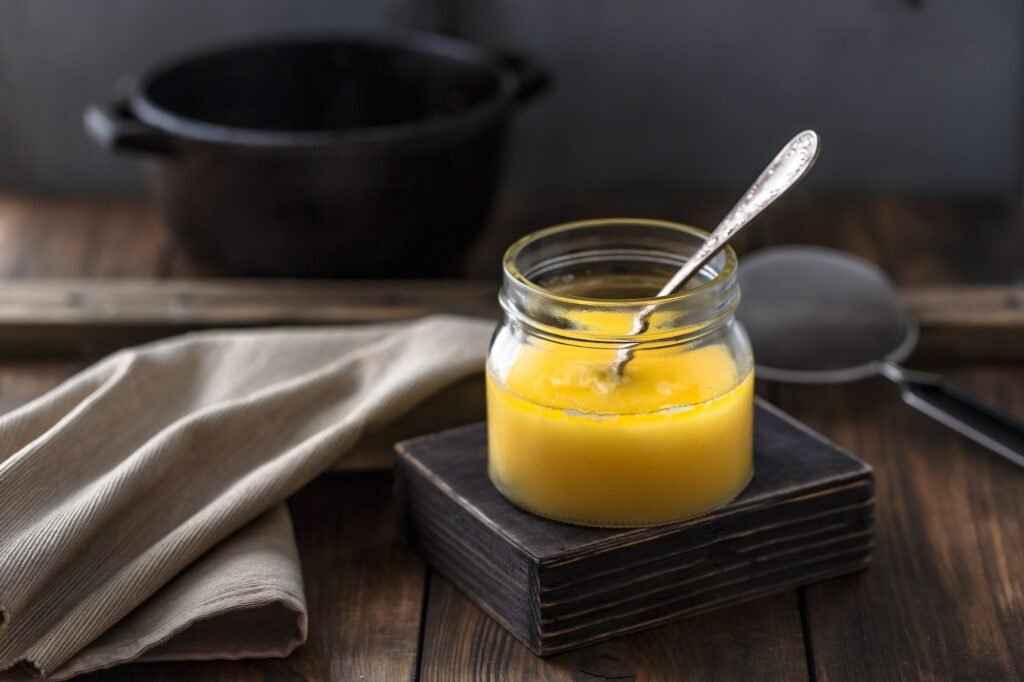
Another great way to spice up your dal recipes is by adding herbs like cilantro or mint. Herbs are an excellent way to add an extra layer of flavor and provide a refreshing counterpoint to the earthy flavors present in dals. You can also add freshly chopped onions for some added sweetness or chili peppers for some heat.
For a vegan-friendly alternative, you can use vegan bouillon cubes instead of chicken broth for added depth of flavor and richness without using any animal products.
Finally, you can add coconut milk for a creamy finish that adds richness and body without making the dish too heavy or overly fatty.
Adding spices and herbs together with other flavorful ingredients when preparing your next batch of delicious dal will truly elevate your meal from just another bland bowl of lentils into something special that everyone will enjoy!
Health Benefits of Eating Dal Regularly
Eating dal, which is also known as lentils, can have multiple health benefits for those who consume it regularly. For starters, dal is a great source of protein for vegetarians and vegans. It contains all nine essential amino acids that the body needs to function properly, making it an ideal choice for people who are looking for plant-based sources of protein. Additionally, dal is low in fat and cholesterol-free, making it a much healthier alternative to red meat or poultry.
Dal also has several vitamins and minerals that can benefit the body. It is high in fiber which helps with digestion and provides you with energy throughout the day. Dal also contains important vitamins such as B2, B6 and folate, which are necessary for proper nerve functioning and cell growth. Additionally, it has many minerals such as potassium and magnesium which are beneficial for healthy bones and muscle contraction.
Another health benefit of eating dal regularly is that it can help reduce cholesterol levels in your bloodstream. Dal contains soluble fiber which binds to cholesterol in your digestive system so that it can be excreted from your body instead of being absorbed into your blood vessels. This process helps keep cholesterol levels down and may even lower your risk of heart disease in the long run.
Finally, eating dal regularly may help you maintain a healthy weight due to its low-calorie content compared to other sources of protein like beef or chicken. Not only does this make it a great substitute if you’re trying to lose weight but its high fiber content will also keep you feeling fuller longer so you don’t feel the need to snack between meals as much.
All in all, eating dal regularly can offer numerous health benefits ranging from improved digestion to lower cholesterol levels and even aid with weight loss goals!
Conclusion
Dal is a staple of Indian cuisine, and it’s not hard to see why. It has a delicious flavor that can be adapted to suit any dish, making it perfect for a variety of recipes. Plus, it’s incredibly easy to make – all you need is some dal, a few spices, and a few minutes! But how do you make sure your dal comes out perfectly every time?
The key to making great dal lies in its preparation. Make sure you rinse off any excess starch from the dal before you begin cooking, as this will help ensure the dal cooks evenly without becoming too soft or mushy. You’ll also want to pay attention to how much water you add – start with less than you think you’ll need and then adjust accordingly if needed. Too much water will dilute the flavor of your dal, while too little might result in an overly-dry texture. Once you have the right amount of liquid added, let the dal simmer until most of the liquid has evaporated. This should take between 20-30 minutes depending on what type of dal you are using.
When seasoning your dal, don’t skimp on spices! Adding enough cumin, coriander powder and turmeric will give your dish an authentic Indian flavor. Before serving your dal, make sure to check for salt and adjust accordingly – too little can leave your dish tasting flat, while too much can ruin even the best of recipes! Finally, before serving top with fresh chopped herbs such as cilantro or parsley for an extra burst of flavor.
By following these simple steps you can guarantee perfect results every time when making delicious dal dishes at home!
By following the tips and tricks in this post, you’ll be able to make perfect dal every time using a rice cooker. Whether you’re cooking for yourself or for a large group, dal is always a delicious and healthy option. And with a rice cooker, it’s easier than ever to get the perfect consistency and flavor. So next time you’re looking for an easy and tasty meal, give dal a try! Read more here about other recipes you can make using a rice cooker.


